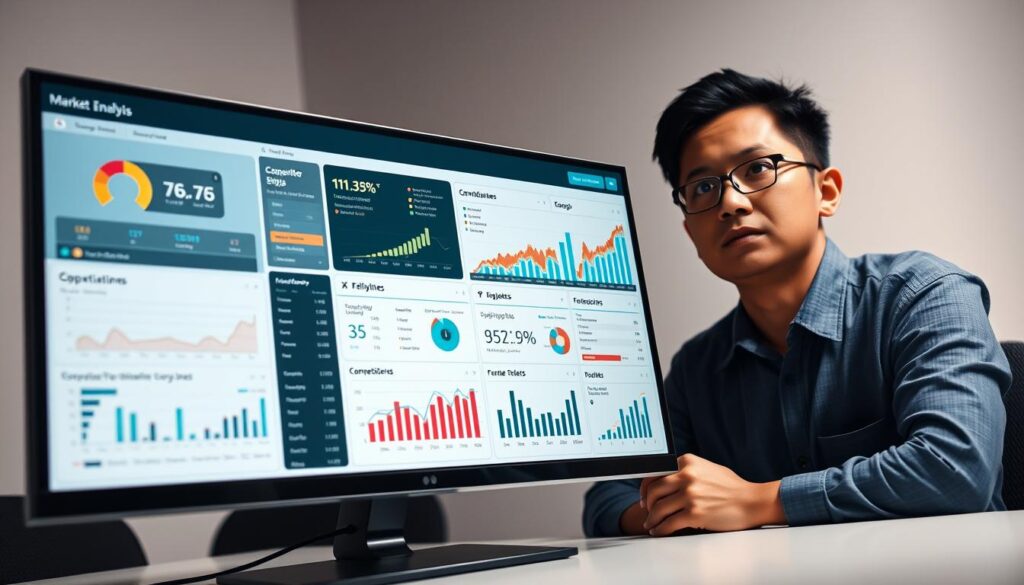How are businesses in the Philippines using AI to grow? Artificial intelligence is changing how companies find and use new markets. This article will show how AI helps spot customer trends and expand markets. It will give you tips to stay ahead in Southeast Asia.
Key Takeaways
- AI is changing how businesses plan for the future by finding new opportunities.
- Knowing what customers want through AI can really help target better.
- AI helps find new areas to grow by analyzing data.
- Looking at data is key to finding new market trends.
- AI’s success in business shows its power in strategy.
Introduction to AI and Market Opportunities
Artificial intelligence has changed how we do market analysis. It helps businesses find new chances in many fields. With better data processing and learning, companies can dive deeper into market trends.
AI is changing how businesses work and create new things. In places like the Philippines, AI helps firms understand the market, what customers want, and who they’re up against. This way, companies can spot where they can improve and make products that customers really want.
Using AI helps businesses stay ahead. For example, predictive analytics lets them see what customers might want next. Companies looking to grow should look into AI tools for insights.
In short, using AI opens up new ways for businesses to grow. It helps them succeed in a changing market.
The Importance of AI in Business Strategy
Artificial intelligence is changing how businesses plan, mainly in fast-growing markets like Southeast Asia. By using AI, companies can work more efficiently. This means they spend less and offer better services. Knowing the AI market growth factors helps businesses stay up-to-date with new tech.
AI makes it easier to make smart choices by using data. This data helps businesses spot trends and meet customer needs quickly. In today’s fast world, knowing what customers want is key to staying ahead. AI helps companies understand the market better, leading to smarter plans.
The future of AI technology looks even brighter for business strategies. As AI gets better, it will do more complex tasks. This means companies can find new chances in their markets, leading to growth and innovation.
| AI Application | Benefits | Impact on Strategy |
|---|---|---|
| Data Analytics | Enhanced decision-making and operational efficiency | Improved market responsiveness |
| Predictive Modeling | Accurate consumer trend forecasting | Proactive strategy development |
| Automation | Cost savings and improved service delivery | Streamlined operations |

AI Market Opportunities: Uncovering New Avenues for Growth
The business world is changing fast, and AI is at the forefront. It helps companies understand huge amounts of data. This lets them see patterns in what customers like and want.
With these insights, businesses can make smarter choices. They can spot new chances to grow and expand. This is all thanks to AI.
The Impact of Data Analytics on Market Discovery
Data analytics is key in finding new markets. It turns simple data into useful information. Companies use AI to find out what trends and needs are important.
This helps them make better plans. By using AI, they can see when customers want something new. They can then change their products or services to meet these needs. This way, they find and use new market chances.
Examples of Companies Leveraging AI for Market Opportunities
Many companies are using AI to grow. For example, Alibaba and Tencent in Asia are using AI to understand their customers better. They make their services more personal and their marketing more effective.
This not only makes customers happier but also helps these companies grow a lot. They show how AI can help businesses keep getting better and bigger.
Utilizing Customer Trends AI to Predict Market Shifts
Knowing how markets change is key for businesses to lead. Predictive analytics uses customer trends AI to study data and guess future consumer actions. This part explains how these tools improve market studies and guide strategy.
An Overview of Predictive Analytics in Market Research
Predictive analytics uses stats and algorithms to spot trends in past data. It uses customer trends AI to guess what will happen next. Companies can look at buying habits, seasonal trends, and what customers like. This gives them insights for making choices.
- Analyzes historical data to find significant correlations
- Enables businesses to make informed decisions based on predictive outcomes
- Optimizes marketing strategies through understanding customer behaviors
Case Studies from Asian Markets
Asian markets have used customer trends AI and predictive analytics to keep up with fast-changing consumers. For example, a top retail company in Japan used predictive analytics to guess demand for seasonal items. By looking at past sales, they managed their stock better, saving money and making customers happier.
In South Korea’s food and drink industry, companies used customer trends AI to get what people wanted because of health trends. This knowledge helped them launch healthy product lines that fit what people were looking for.
| Company | Sector | Impact of Predictive Analytics |
|---|---|---|
| Retail Corp Japan | Retail | Optimized inventory and boosted sales during seasonal peaks |
| Health Foods Korea | Food & Beverage | Introduced new product lines catering to health trends |

Market Expansion AI: Strategies for Growth
In today’s fast-paced world, AI helps businesses grow by refining their strategies. AI lets companies target specific audiences and find new markets. This part explains how AI improves market segmentation and finds valuable niches.
How AI Enhances Market Segmentation
AI tools look at huge amounts of data, finding patterns humans might miss. They use different data sources to segment markets by demographics, buying habits, and preferences. This targeted approach boosts marketing, increases customer engagement, and drives sales.
The precision of AI-driven analysis increases accuracy in understanding consumer needs, which is vital for developing effective marketing strategies.
Identifying Niche Markets through AI Analysis
AI makes finding niche markets easier. It analyzes consumer behavior and preferences to spot underserved areas. Tailoring products or services for these niches can build strong brand loyalty and reduce competition.
| Niche Market | Target Audience | Potential Growth Impact |
|---|---|---|
| Eco-Friendly Products | Environmentally Conscious Consumers | High Demand, Increasing Loyalty |
| Pet Technology | Tech-Savvy Pet Owners | Rapid Growth, Emerging Trends |
| Organic Skincare | Health-Conscious Consumers | Steady Growth, Brand Differentiation |
Using AI for market segmentation helps businesses stay ahead. It lets them grow by using AI insights to find new opportunities. This proactive approach helps businesses capture growth that might be missed.
Leveraging Machine Learning for Market Insight
Machine learning has changed how we analyze markets. It lets businesses find deep insights from lots of data. Advanced algorithms help spot patterns and connections that are hard to see, leading to smarter choices.
Some key strategies in using machine learning for market analysis include:
- Data Mining: This method pulls out important info from big datasets. It helps find trends and what customers like.
- Predictive Modeling: It uses stats to guess what the market will do next. This helps businesses stay ahead of rivals.
- Anomaly Detection: It finds odd patterns in data. These can show big changes in the market that need quick action.
Companies that use machine learning can keep up with changing markets better. They can improve their plans and run their operations more smoothly. With the right tools, artificial intelligence market analysis can help many areas grow and innovate.

Natural Language Processing and Its Role in Market Analysis
Natural Language Processing (NLP) is a key tool for businesses. It helps them understand what customers think and feel. By looking at lots of data from feedback, NLP uncovers feelings that shape market plans.
Companies can see what people say in reviews, on social media, and in surveys. This lets them make their products better and make customers happier.
Understanding Consumer Sentiment through NLP
NLP is great at figuring out what people think. It shows how customers feel about what they buy. It can tell if opinions are good, bad, or somewhere in between.
This helps brands make smart choices. They can change their ways to better meet what customers want.
Case Examples of Effective NLP in Action
Many brands use NLP well. For example, British Airways looked at what people said on social media and in customer service chats. They found out what was bothering customers and made their service better.
Sephora uses NLP to understand what people say about their products. This helps them decide what to stock and how to market it.
| Brand | NLP Application | Outcome |
|---|---|---|
| British Airways | Social media sentiment analysis | Improved customer support services |
| Sephora | Product review analysis | Optimized inventory and marketing |
| Pantene | Sentiment analysis on product satisfaction | Improved product formulations |
AI-Driven Competitive Analysis
Knowing the competitive landscape is key for any business to succeed today. AI helps companies understand their rivals’ moves, giving them an edge. This is crucial for spotting market chances and meeting customer needs.
Using AI to Analyze Competitors’ Strategies
AI tools help businesses understand competitors’ actions deeply. They use advanced algorithms to track data like marketing, pricing, and new products. This helps firms make smart choices and grasp the market better.
“Utilizing AI for competitive analysis transforms how businesses strategize, ensuring they stay ahead in a rapidly evolving market.”
Some key methods include:
- Web Scraping: Collects data from rivals’ sites to watch for new services.
- Sentiment Analysis: Sees what customers say about rivals’ products to spot their good and bad points.
- Sales Trend Analysis: Looks at sales data to see how the market is doing.
The table below shows how AI tools help in competitive analysis:
| AI Tool | Purpose | AI Market Growth Factors Addressed |
|---|---|---|
| Data Mining Software | Extracts useful info from big datasets | Finds market trends and what customers like |
| Machine Learning Models | Predicts what rivals might do next | Better decisions in market strategy |
| Natural Language Processing | Gets the gist of customer feelings and reviews | Better product placement and marketing |
Using AI for competitive analysis boosts strategic views and meets market needs. By using AI, companies can stay ahead and keep their edge.
AI’s Contribution to Forecasting Market Trends
In today’s fast-paced business world, knowing market trends is key for making smart decisions. AI helps a lot in this area, using big data to give insights. Companies can use AI to predict changes and stay ahead of rivals.
AI uses smart algorithms to look at past data and find patterns. This helps businesses make quick decisions and adapt to market changes. Using AI well lets companies adjust their plans based on current data.
AI also lets businesses try out different market scenarios. This helps them plan their products and marketing better. As AI gets better, companies can find more ways to succeed in a changing world.
| Forecasting Technique | Description | AI Market Opportunities |
|---|---|---|
| Predictive Analytics | Uses past data to guess future trends. | Finds out what customers might want next. |
| Sentiment Analysis | Looks at customer feedback to see how people feel. | Gives tips for improving products and marketing. |
| Time Series Analysis | Studies data over time to spot trends. | Helps with planning for seasonal changes and demand. |
| Scenario Planning | Creates models of different market scenarios. | Helps businesses get ready for different futures. |
Challenges in Implementing AI for Market Opportunity Identification
Businesses face many challenges when using AI to find new market opportunities. It’s important to overcome these hurdles to fully benefit from AI.
Data Privacy and Quality Concerns
Data privacy and quality are big challenges. Companies must follow strict data protection laws like GDPR and local laws in Southeast Asia. Not following these laws can harm a company’s reputation.
Good data is key for AI to work well. Bad data can give wrong insights. So, it’s crucial to clean and validate data carefully.
Building the Necessary Infrastructure for AI
Setting up AI tools needs a strong infrastructure. This can be expensive. Companies need the right technology and skilled people to use AI effectively.
Many in Southeast Asia struggle with old systems. To solve this, working with tech partners and training employees can help. This way, teams can use AI to analyze markets better.

| Challenge | Description | Potential Solutions |
|---|---|---|
| Data Privacy | Compliance with regulations to protect consumer data. | Implement data protection strategies and employee training on privacy laws. |
| Data Quality | Poor data quality can lead to misleading insights. | Develop data cleansing and validation processes. |
| Infrastructure | Need for robust technological foundations. | Partner with tech firms and invest in scalable solutions. |
Future of AI Technology in Business
The future of AI in business is full of exciting opportunities. As technology advances, companies in the Philippines need to adapt. They must use new solutions to reach their full market potential.
Companies that adopt AI will likely grow a lot. They can make better decisions with data-driven insights. This helps them stay ahead in the market.
New AI trends include better automation, natural language processing, and machine learning. These tools help businesses understand what customers want. They can then offer products that meet those needs, making customers happier.
AI is changing many industries like retail, healthcare, and finance. For example, AI helps retailers in Southeast Asia predict what products to stock. This ensures they have what customers want and avoid waste.
Healthcare providers are also using AI to improve patient care. They create personalized treatment plans using big data. This leads to better health outcomes for patients.
To stay competitive, businesses need to be innovative. They can invest in AI training, work with tech startups, or test new AI tools. Embracing AI will help them grow and lead in their markets.
Conclusion
In today’s fast-changing business world, understanding AI’s role in finding new market chances is crucial. Companies that use AI can better follow customer trends and make smart growth plans. Those who use AI well will likely do well in the long run.
Using AI to expand into new markets helps businesses find hidden opportunities. AI in market research improves data analysis and boosts innovation. This leads to better business results.
The main point for companies is to make AI a key part of their plans. This way, they can use AI to stay ahead and adapt to market changes. For more on how to use AI for growth, check out Tellix.
FAQ
What are the benefits of using AI in market opportunity identification?
AI helps businesses use big data for smart insights. It makes operations more efficient and decisions better. It also uncovers customer trends, keeping companies competitive.
How does predictive analytics influence market research?
Predictive analytics uses past data to predict market changes. This lets businesses make smart choices. It helps them understand and adapt to market shifts.
What are effective market segmentation strategies powered by AI?
AI improves market segmentation by analyzing consumer data. It finds niche markets and customizes marketing. This targeted approach boosts growth and innovation.
Can you provide examples of how companies in Asia are using AI to identify market opportunities?
Asian companies use AI to understand customer behavior and preferences. This leads to new products and effective market strategies. These examples show AI’s power in growth and expansion.
How can organizations leverage machine learning for market insights?
Machine learning analyzes large data sets to predict trends. This lets businesses quickly respond to market changes. It helps them seize new opportunities.
What role does Natural Language Processing (NLP) play in understanding customer sentiment?
NLP analyzes unstructured data from feedback and reviews. It helps businesses understand customer feelings. This gives them insights to improve their strategies.
How can AI-driven competitive analysis enhance my business strategy?
AI-driven analysis reveals competitors’ strategies and market gaps. It helps businesses refine their offerings. This strengthens their market position.
What challenges do businesses face when implementing AI for market opportunities?
Businesses face data privacy and quality issues, and need strong AI infrastructure. Overcoming these hurdles is key to successful AI use.
What future trends can we expect from AI technology in business?
Future AI trends include advanced analytics, personalization, and efficiency. Companies that adopt these technologies will optimize market opportunities and lead competitors.

